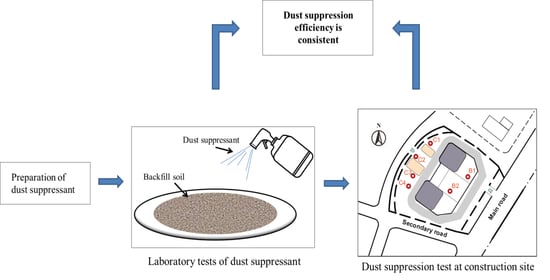Suppression Effect of Waterborne Polymer on Soil Used for Backfilling at Construction Site
Abstract
:1. Introduction
2. Materials and Methods
2.1. Preparation of Dust Samples
2.2. Preparation of Dust Suppressants
2.3. Experimental Instruments and Test Methods
3. Results
3.1. Interaction between Polymers and Soil for Backfilling
3.1.1. Wettability of Soil for Backfilling with Dust Suppressants
3.1.2. Zeta Potential of the Stabilized Backfill Powder
3.2. Wet Dust Suppression Performance of Polymers
3.2.1. Change in the Moisture Content of Soil for Backfilling during Drying
3.2.2. Effect of Polymers on the Equilibrium Moisture Content
3.2.3. Dust Suppression Efficiency of Waterborne Polymers
3.2.4. Dust Suppression Duration of the Stabilized Soil for Backfilling
3.3. Dry Dust Suppression Performance of Waterborne Polymers
3.4. Safety of Polymer Dust Suppressants
3.5. Effect of Dust Suppression at a Construction Site
4. Discussions
5. Conclusions
- (1)
- The contact angle between the waterborne polymer dust suppressant and the soil for backfilling at construction sites, as well as the Zeta potential of the stabilized soil for backfilling, were studied. The polymer improved the interaction between the backfill particles, the average moisture content during drying increased by 118.8%, and the stability of the backfill was significantly enhanced.
- (2)
- The wet dust suppression performance was evaluated against time, where the dust suppression efficiency was at least 60%. With a polymer mass of 1.04%, the dust suppression efficiency of PM10 at 35 °C and 45% RH reached 78.95%, and the dust suppression efficiency lasting until day 5 was 64.47%.
- (3)
- The dry dust suppression performance was examined with compression strength at room temperature. The waterborne polymer promoted the aggregation and cohesion of fine particles below 10 μm, and the strength on day 28 reached 4.97 MPa, which was 3.94 times higher than that of the watered samples. It was, therefore, concluded that the waterborne polymer could effectively resist wind-blown dust, and the stabilized soil for backfilling exhibited high stability.
- (4)
- According to the results at the construction site, the dust suppression efficiencies for PM10 and PM2.5 reached 67.41 and 53.68%, respectively, which was consistent with the estimated results. It confirmed the feasibility of the evaluation method used in this paper and the onsite stabilization effect of the polymer.
- (5)
- At 15 days after stabilization, the surface crust of the soil for backfilling was stable, and the plant growth was unaffected, so the polymer exhibited good environmental safety. The above results provide material and method support for dust suppression at construction sites.
Author Contributions
Funding
Institutional Review Board Statement
Informed Consent Statement
Data Availability Statement
Acknowledgments
Conflicts of Interest
References
- Aslam, A.; Ibrahim, M.; Shahid, I.; Mahmood, A.; Irshad, M.K.; Yamin, M.; Ghazala; Tariq, M.; Shamshiri, R.R. Pollution Characteristics of Particulate Matter (PM2.5 and PM10) and Constituent Carbonaceous Aerosols in a South Asian Future Megacity. Appl. Sci. 2020, 10, 8864. [Google Scholar] [CrossRef]
- Borja, L.; César, S.; Cunha, R.; Kiperstok, A. A Quantitative Method for Prediction of Environmental Aspects in Construction Sites of Residential Buildings. Sustainability 2018, 10, 1870. [Google Scholar] [CrossRef] [Green Version]
- Xu, Y.; Zhou, Z.; Huang, Y.; Wang, K.; Nie, T.; Nie, L.; Qin, J. Fugitive Dust Emission Characteristics from Building Construction Sites of Beijing. Environ. Sci. 2017, 38, 2231–2237. (In Chinese) [Google Scholar] [CrossRef]
- Wei, D.; Du, C.; Lin, Y.; Chang, B.; Wang, Y. Temporal–Spatial Distribution of Vehicle Transportation Pavement Dust Migration in an Open-Pit Mine. ACS Omega 2020, 5, 16030–16036. [Google Scholar] [CrossRef] [PubMed]
- MEPC. Technical Guidelines for the Preparation of Dust Source Particulate Matter Emission Inventory (On Trial); MEPC: Beijing, China, 2014; Available online: https://www.mee.gov.cn/gkml/hbb/bgg/201501/W020150107594588131490.pdf (accessed on 25 April 2017).
- Ikeagwuani, C.C.; Nwonu, D.C. Emerging trends in expansive soil stabilisation: A review. J. Rock Mech. Geotech. Eng. 2019, 11, 423–440. [Google Scholar] [CrossRef]
- Mirzababaei, M.; Arulrajah, A.; Ouston, M. Polymers for Stabilization of Soft Clay Soils. Procedia Eng. 2017, 189, 25–32. [Google Scholar] [CrossRef]
- Parvej, S.; Naik, D.L.; Sajid, H.U.; Kiran, R.; Huang, Y.; Thanki, N. Fugitive Dust Suppression in Unpaved Roads: State of the Art Research Review. Sustainability 2021, 13, 2399. [Google Scholar] [CrossRef]
- Lu, Z.; Lei, Z.; Zafar, M.N. Synthesis and performance characterization of an efficient environmental-friendly Sapindus mukorossi saponins based hybrid coal dust suppressant. J. Clean. Prod. 2021, 306, 127261. [Google Scholar] [CrossRef]
- Katra. Comparison of Diverse Dust Control Products in Wind-Induced Dust Emission from Unpaved Roads. Appl. Sci. 2019, 9, 5204. [Google Scholar] [CrossRef] [Green Version]
- Rica, H.C.; Saussaye, L.; Boutouil, M.; Leleyter, L.; Baraud, F. Stabilization of a silty soil: Effects of disruptive salts. Eng. Geol. 2016, 208, 191–197. [Google Scholar] [CrossRef]
- Xu, L.; Pei, Z. Preparation and Optimization of a Novel Dust Suppressant for Construction Sites. J. Mater. Civ. Eng. 2017, 29, 04017051. [Google Scholar] [CrossRef]
- Tong, Y.; Liu, Y.; Su, L.; Ji, Y.; Zhang, F. Adhesion of VAc copolymer emulsion to road floating dust. China Adhes. 2018, 27, 21–23. (In Chinese) [Google Scholar] [CrossRef]
- Fan, T.; Zhou, G.; Wang, J. Preparation and characterization of a wetting-agglomeration-based hybrid coal dust suppressant. Process Saf. Environ. Prot. 2018, 113, 282–291. [Google Scholar] [CrossRef]
- Wang, Y.; Du, C.; Cui, M. Formulation Development and Performance Characterization of Ecological Dust Suppressant for Road Surfaces in Cities. Appl. Sci. 2021, 11, 10466. [Google Scholar] [CrossRef]
- Jin, H.; Zhang, Y.; Chen, K.; Niu, K.; Wu, G.; Wei, X.; Wang, H. Preparation and Characterization of a Composite Dust Suppressant for Coal Mines. Polymers 2020, 12, 2942. [Google Scholar] [CrossRef]
- Li, S.; Zhou, G.; Liu, Z.; Wang, N.; Wei, Z.; Liu, W. Synthesis and performance characteristics of a new ecofriendly crust-dust suppressant extracted from waste paper for surface mines. J. Clean. Prod. 2020, 258, 120620. [Google Scholar] [CrossRef]
- Mingyue, W.; Xiangming, H.; Qian, Z.; Wei, L.; Yanyun, Z.; Zhenglong, H. Study on preparation and properties of environmentally-friendly dust suppressant with semi-interpenetrating network structure. J. Clean. Prod. 2020, 259, 120870. [Google Scholar] [CrossRef]
- Zhao, Z.; Zhao, Y.; Hu, X.; Cheng, W.; Hou, J.; Song, C. Preparation and performance analysis of enteromorpha-based environmentally friendly dust suppressant. Powder Technol. 2021, 393, 323–332. [Google Scholar] [CrossRef]
- Zhu, Y.; Cui, Y.; Shan, Z.; Dai, R.; Shi, L.; Chen, H. Fabrication and characterization of a multi-functional and environmentally-friendly starch/organo-bentonite composite liquid dust suppressant. Powder Technol. 2021, 391, 532–543. [Google Scholar] [CrossRef]
- Wu, M.; Hu, X.; Zhang, Q.; Zhao, Y.; Sun, J.; Cheng, W.; Fan, Y.; Zhu, S.; Lu, W.; Song, C. Preparation and performance evaluation of environment-friendly biological dust suppressant. J. Clean. Prod. 2020, 273, 123162. [Google Scholar] [CrossRef]
- Zhu, S.; Hu, X.; Zhao, Y.; Fan, Y.; Wu, M.; Cheng, W.; Wang, P.; Wang, S. Coal Dust Consolidation Using Calcium Carbonate Precipitation Induced by Treatment with Mixed Cultures of Urease-Producing Bacteria. Water Air Soil Pollut. 2020, 231, 442. [Google Scholar] [CrossRef]
- Yan, H.; Ding, G.; Li, H.; Wang, Y.; Zhang, L.; Shen, Q.; Feng, K. Field Evaluation of the Dust Impacts from Construction Sites on Surrounding Areas: A City Case Study in China. Sustainability 2019, 11, 1906. [Google Scholar] [CrossRef] [Green Version]
- Jiao, C.; Sun, L.; Shao, Q.; Song, J.; Hu, Q.; Naik, N.; Guo, Z. Advances in Waterborne Acrylic Resins: Synthesis Principle, Modification Strategies, and Their Applications. ACS Omega 2021, 6, 2443–2449. [Google Scholar] [CrossRef] [PubMed]
- Teng, H.; Kwigizile, V.; Karakouzian, M.; James, D.E. Etyemezian, V. Investigation of the AP-42 Sampling Method. J. Air Waste Manage. Assoc. 2012, 58, 1422–1433. [Google Scholar] [CrossRef]
- Su, L.; Ji, Y.; Zhang, F.; Yang, S.; Yang, H.; Xiao, Q. Dust suppression performance and field application of waterborne polymer on iron ore powder. Chin. J. Environ. Eng. 2019, 13, 2181–2188. (In Chinese) [Google Scholar] [CrossRef]
- Mendez, M.J.; Aimar, S.B.; Buschiazzo, D.E. PM10 emissions from aggregate fractions of an Entic Haplustoll under two contrasting tillage systems. Aeolian Res. 2015, 19, 195–201. [Google Scholar] [CrossRef]
- Katra, I.; Elperin, T.; Fominykh, A.; Krasovitov, B.; Yizhaq, H. Modeling of particulate matter transport in atmospheric boundary layer following dust emission from source areas. Aeolian Res. 2016, 20, 147–156. [Google Scholar] [CrossRef]
- Aimar, S.B.; Mendez, M.J.; Funk, R.; Buschiazzo, D.E. Soil properties related to potential particulate matter emissions (PM10) of sandy soils. Aeolian Res. 2012, 3, 437–443. [Google Scholar] [CrossRef]
- Bae, S.; Inyang, H.I.; De Brito Galvão, T.C.; Mbamalu, G.E. Soil desiccation rate integration into empirical dust emission models for polymer suppressant evaluation. J. Hazard. Mater. 2006, 132, 111–117. [Google Scholar] [CrossRef]
- Zhao, P.; Feng, Y.; Zhang, Y.; Zhu, T.; Jin, J.; Zhang, X. Modeling and impact study of fugitive dust emissions from building construction sites. China Environ. Sci. 2009, 29, 567–573. (In Chinese) [Google Scholar]
- Avecilla, F.; Panebianco, J.E.; Buschiazzo, D.E. Meteorological conditions during dust (PM10) emission from a tilled loam soil: Identifying variables and thresholds. Agric. For. Meteorol. 2017, 244, 21–32. [Google Scholar] [CrossRef]
- Li, M.; Chai, S.; Du, H.; Zhang, J.; Wang, Z. Use of SH dust-depressor for rain erosion control of soil in construction. Chin. J. Environ. Eng. 2016, 10, 3105–3110. (In Chinese) [Google Scholar] [CrossRef]
- Hoffmann, C.; Funk, R. Diurnal changes of PM10-emission from arable soils in NE-Germany. Aeolian Res. 2015, 17, 117–127. [Google Scholar] [CrossRef]
- De Oro, L.A.; Colazo, J.C.; Avecilla, F.; Buschiazzo, D.E.; Asensio, C. Relative soil water content as a factor for wind erodibility in soils with different texture and aggregation. Aeolian Res. 2019, 37, 25–31. [Google Scholar] [CrossRef]
- Madden, N.M.; Southard, R.J.; Mitchell, J.P. Soil water and particle size distribution influence laboratory-generated PM10. Atmos. Environ. 2010, 44, 745–752. [Google Scholar] [CrossRef]
- Alfaro, S.C. Influence of soil texture on the binding energies of fine mineral dust particles potentially released by wind erosion. Geomorphology 2008, 93, 157–167. [Google Scholar] [CrossRef]
- Tadayonnejad, M.; Mosaddeghi, M.R.; Dashtaki, S.G. Changing soil hydraulic properties and water repellency in a pomegranate orchard irrigated with saline water by applying polyacrylamide. Agric. Water Manag. 2017, 188, 12–20. [Google Scholar] [CrossRef]
- Andry, H.; Yamamoto, T.; Irie, T.; Moritani, S.; Inoue, M.; Fujiyama, H. Water retention, hydraulic conductivity of hydrophilic polymers in sandy soil as affected by temperature and water quality. J. Hydrol. 2009, 373, 177–183. [Google Scholar] [CrossRef]
- Lai, S.L.; Chai, Q.; Wang, B.; Yang, N. Preparation and Application of Polymer Dust Suppressants in Coal Transportation under Microwave Irradiation. In Proceedings of the International Conference on Chemical, Material and Metallurgical Engineering (ICCMME 2011), Beihai, China, 23–25 December 2011; pp. 1632–1635. [Google Scholar] [CrossRef]
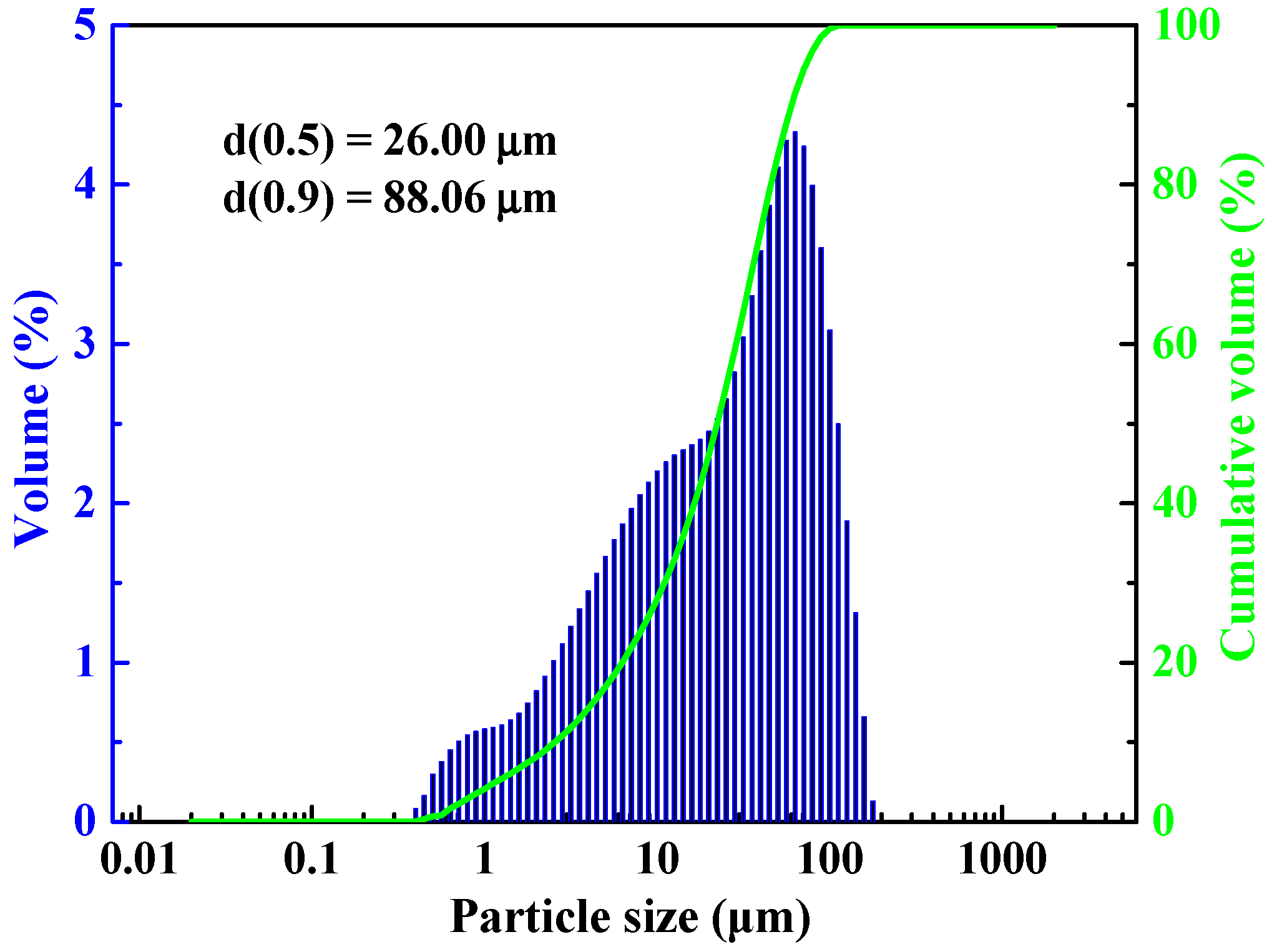
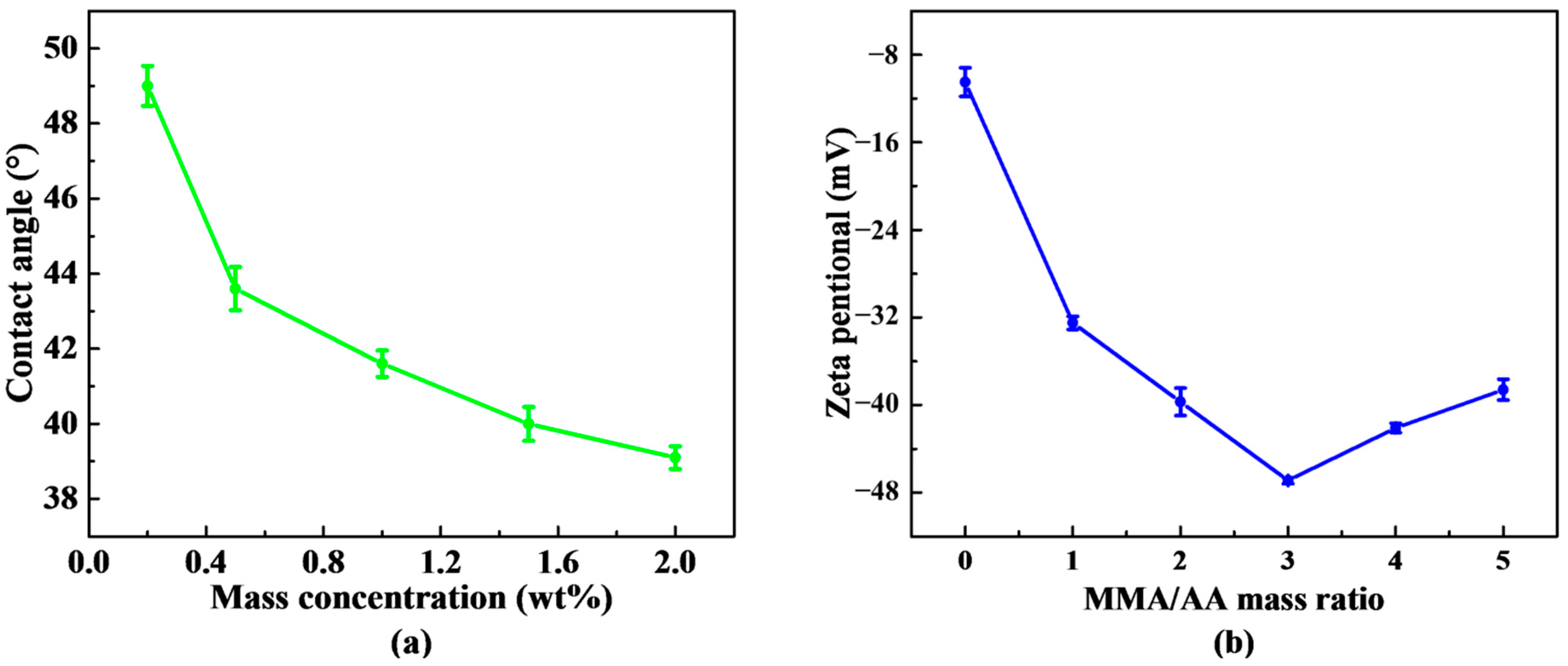
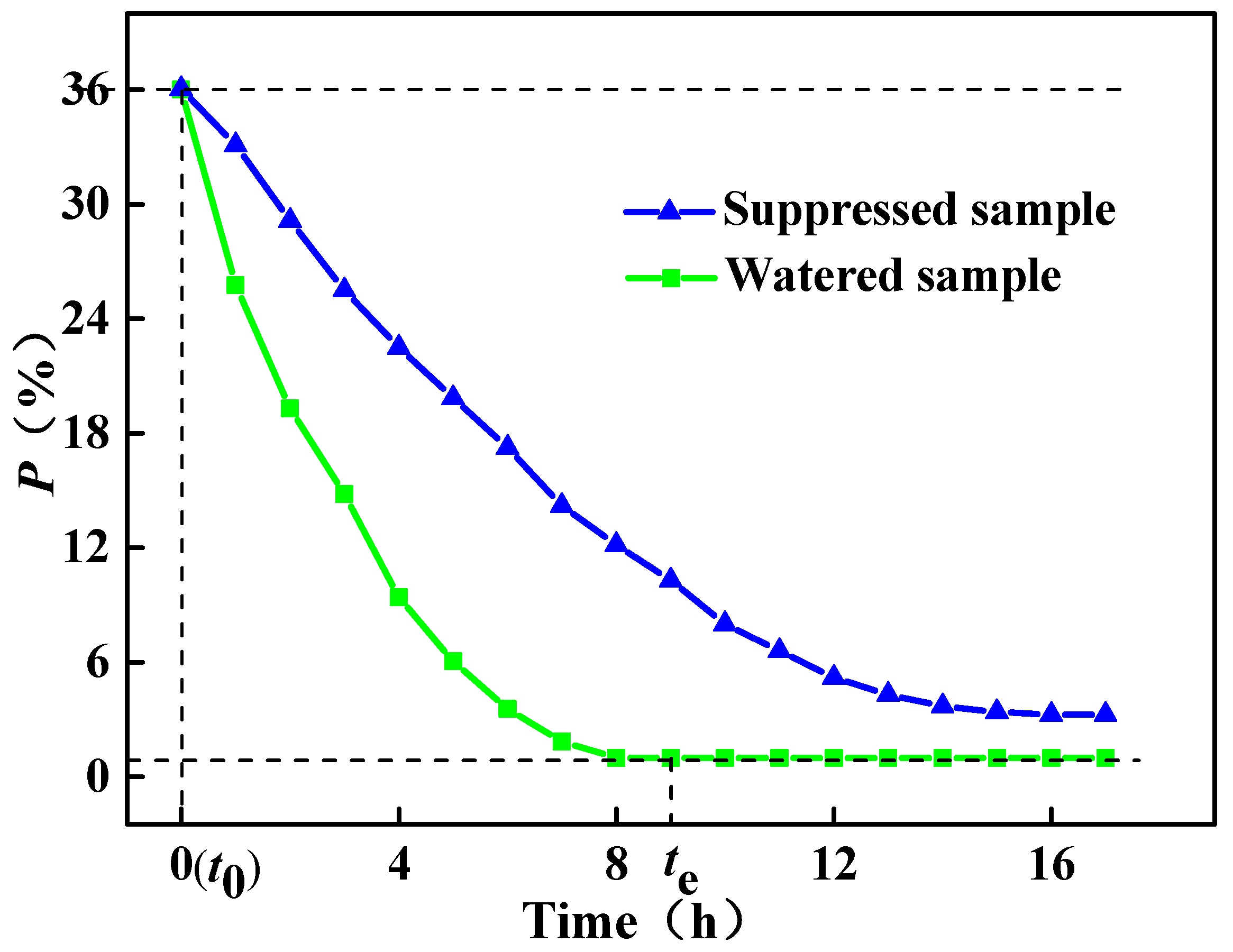
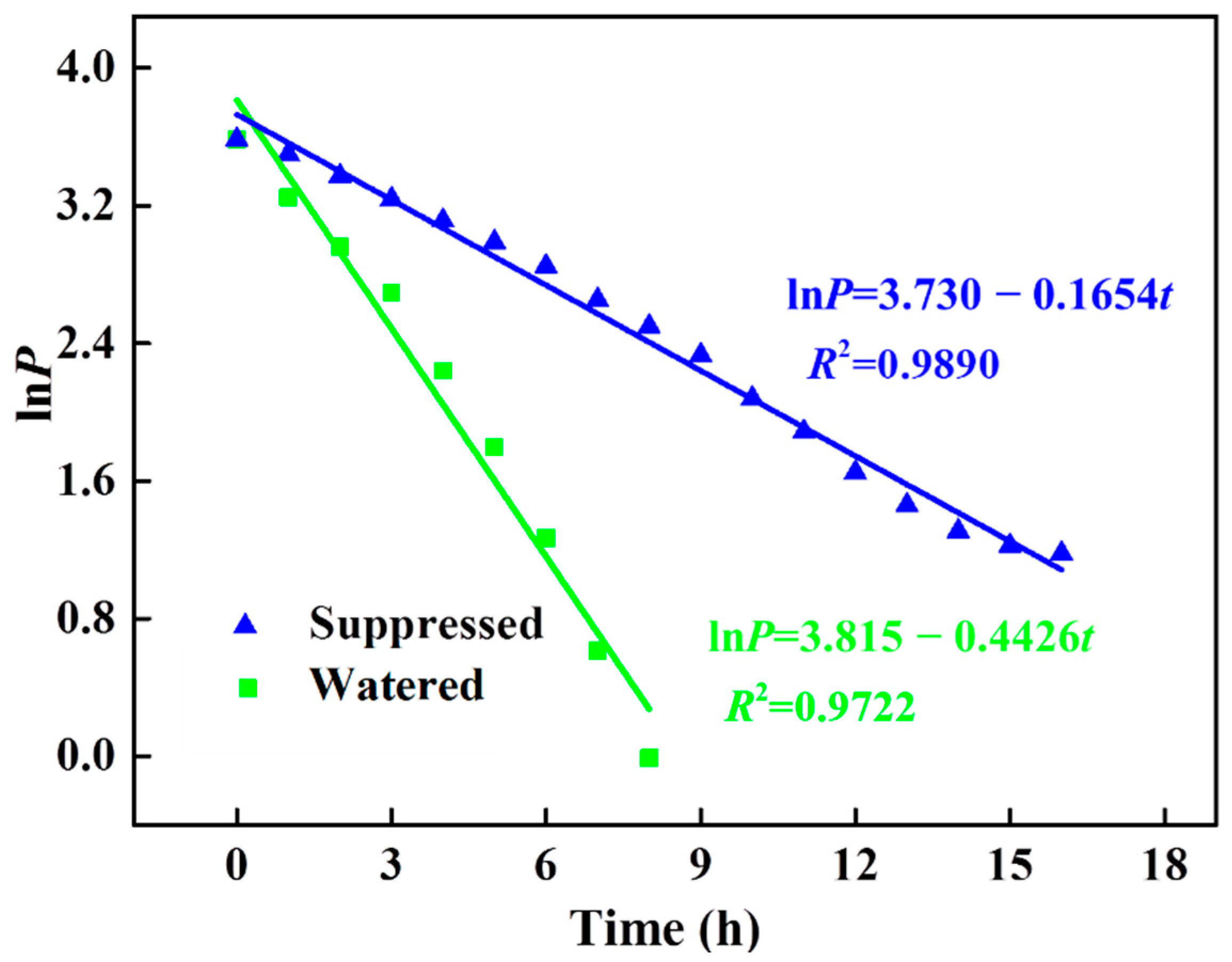
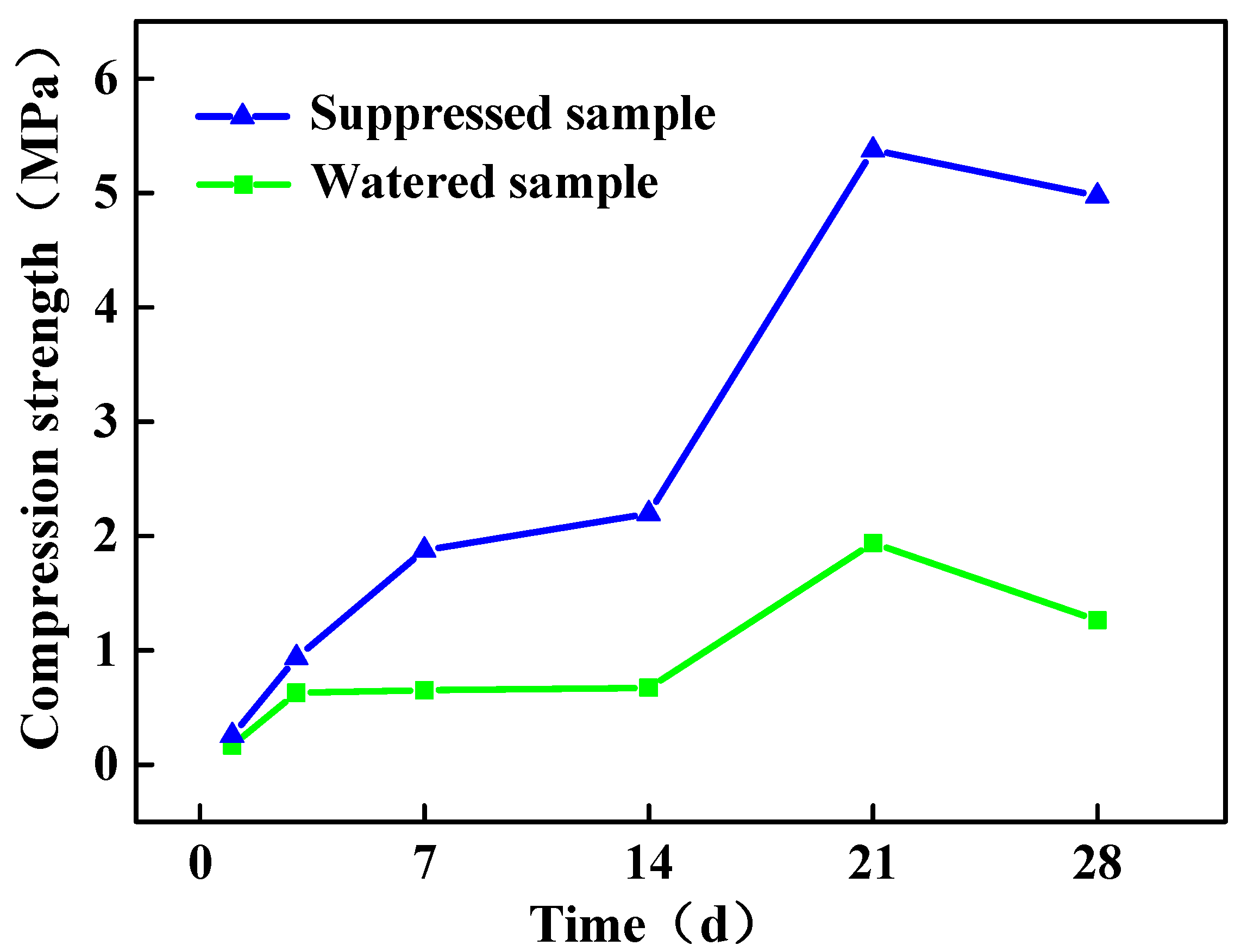
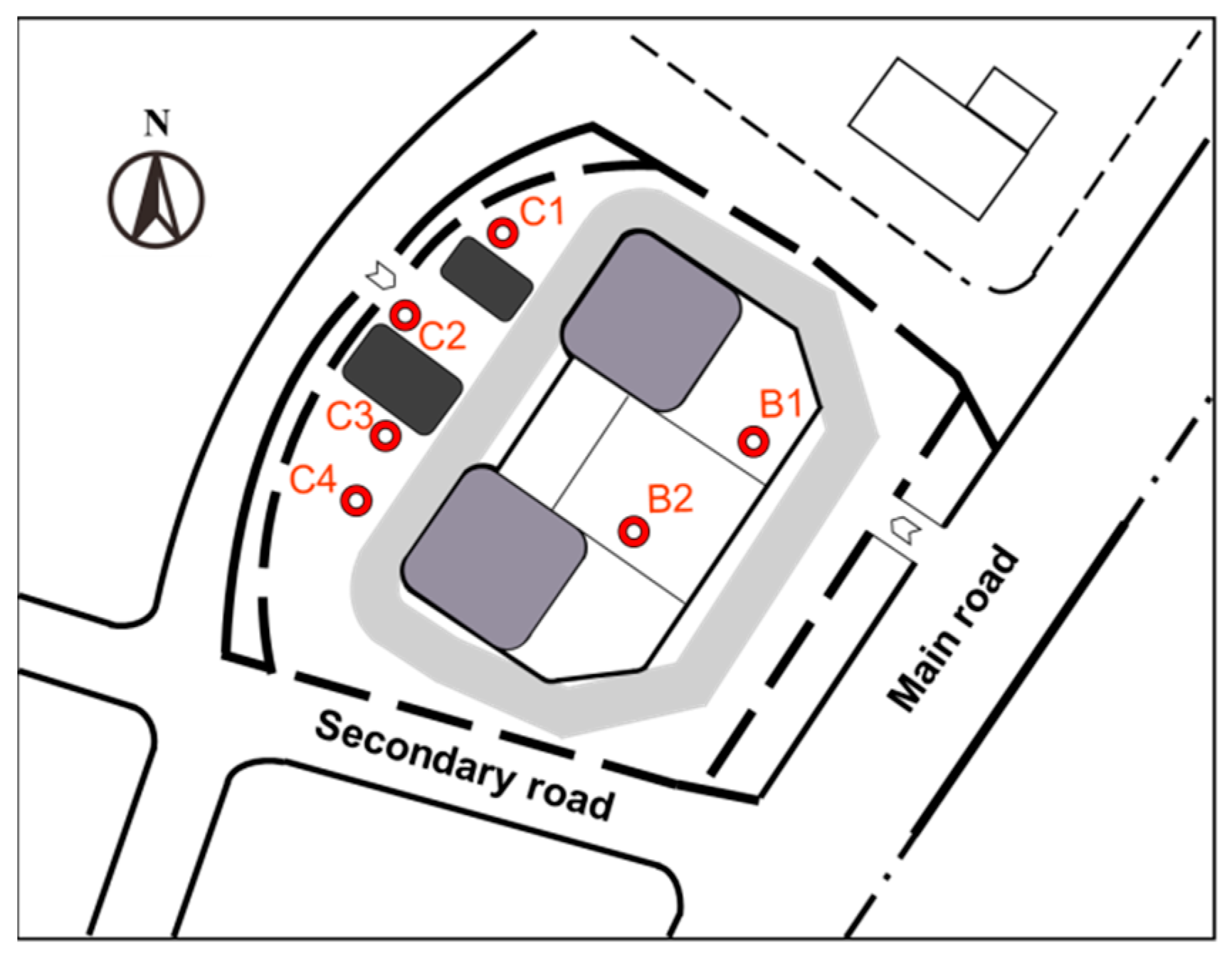
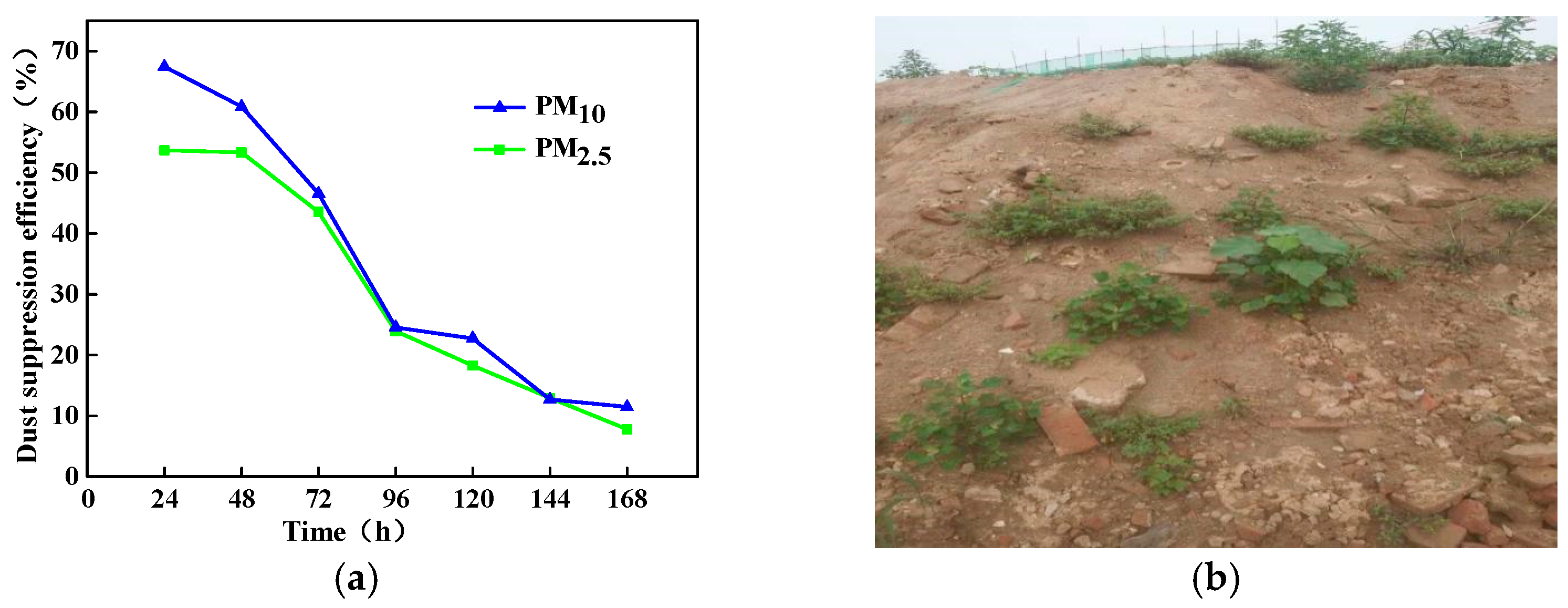
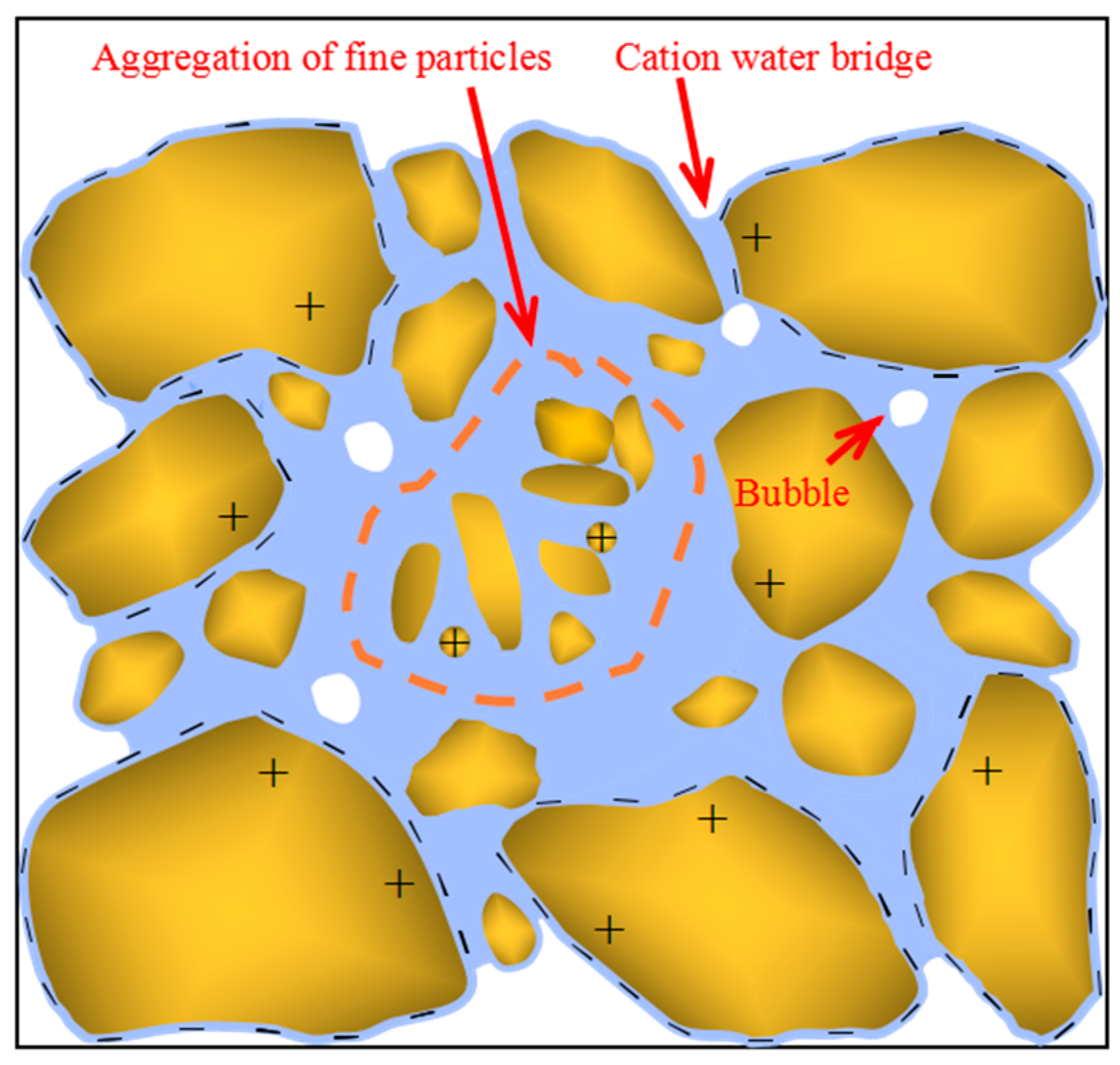
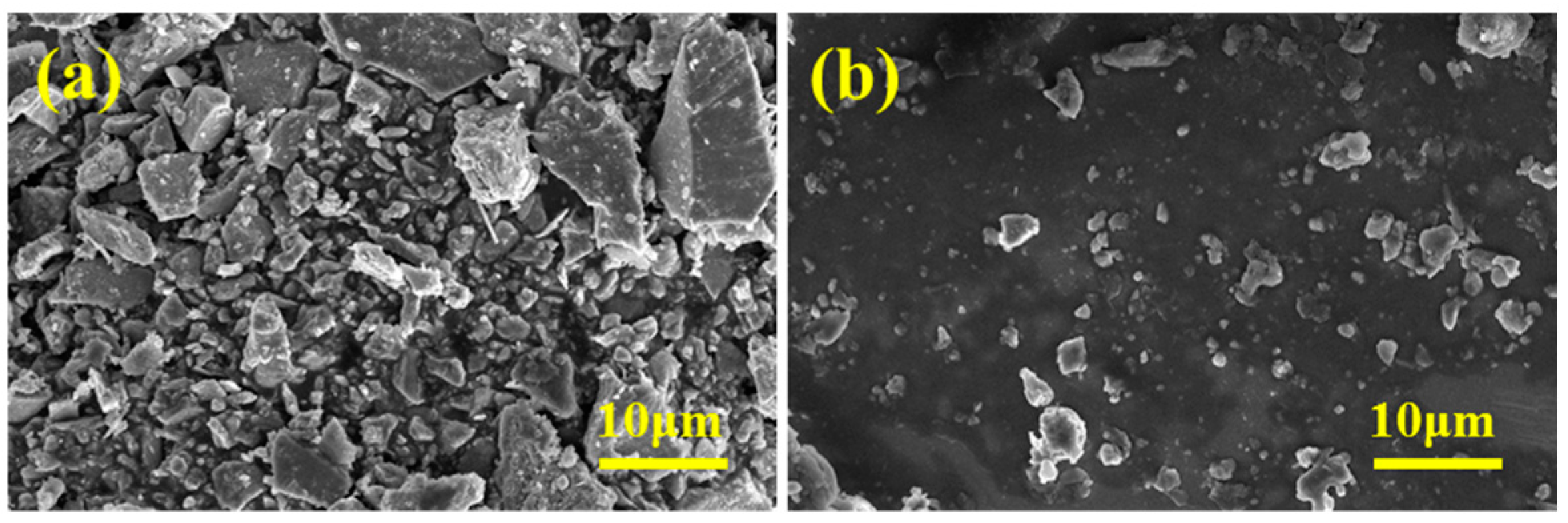
| Name | Purity | Manufacturer |
|---|---|---|
| Acrylic acid (AA) | Industrial grade | Hebei Richu Chemical Co., Ltd., Cangzhou, Hebei, China |
| Butyl acrylate (BA) | Industrial grade | Hebei Richu Chemical Co., Ltd., Cangzhou, Hebei, China |
| Methyl methacrylate (MMA) | Industrial grade | Hebei Richu Chemical Co., Ltd., Cangzhou, Hebei, China |
| Styrene (St) | Industrial grade | Hebei Richu Chemical Co., Ltd., Cangzhou, Hebei, China |
| Emulsifier (EC) | Industrial grade | Hebei Richu Chemical Co., Ltd., Cangzhou, Hebei, China |
| Ammonium persulfate (APS) | Industrial grade | Hebei Richu Chemical Co., Ltd., Cangzhou, Hebei, China |
| Polyacrylic acid resin (PMMA) | Industrial grade | Hebei Richu Chemical Co., Ltd., Cangzhou, Hebei, China |
| Sodium peroxide (NaOH) | Analytically pure | Hebei Richu Chemical Co., Ltd., Cangzhou, Hebei, China |
| Time | lnA | B | R2 |
|---|---|---|---|
| 1 | 3.730 | 0.1654 | 0.9890 |
| 2 | 3.638 | 0.1614 | 0.9869 |
| 3 | 3.617 | 0.1653 | 0.9804 |
| 4 | 3.721 | 0.2038 | 0.9757 |
| 5 | 3.707 | 0.2177 | 0.9823 |
| 6 | 3.673 | 0.2403 | 0.9866 |
| 7 | 3.701 | 0.2620 | 0.9689 |
| Time | Pav/% | EF/g/m2h | η/% |
|---|---|---|---|
| 1 | 13.93 | 0.16 | 78.95 |
| 2 | 12.97 | 0.19 | 75.0 |
| 3 | 12.44 | 0.20 | 73.68 |
| 4 | 11.54 | 0.23 | 69.74 |
| 5 | 10.74 | 0.27 | 64.47 |
| 6 | 9.47 | 0.35 | 53.95 |
| 7 | 8.99 | 0.39 | 48.68 |
| Water-Spraying Treatment | Polymer Stabilization | |
|---|---|---|
| Appearance | Light yellow and transparent | Colorless and transparent |
| Ammonia nitrogen/mg·L−1 | <1 | <0.4 |
| COD/mg·L−1 | 26.3 | 24.6 |
| Items | Detection Limits | Specified Limits | Detection Results |
|---|---|---|---|
| Volatile organic compounds (VOCs)/g·L−1 | 2 | 120 | 3.24 |
| Totals of benzene, methylbenzene, ethylbenzene, and xylene/mg·kg−1 | 50 | 300 | Not detected |
| Free formaldehyde/mg·kg−1 | 5 | 100 | Not detected |
| Soluble heavy metals/mg·kg−1 | 1 | 60 | Not detected |
| Time/h | PM2.5 | PM10 | ||
|---|---|---|---|---|
| Dust Suppression Area | Control Area | Dust Suppression Area | Control Area | |
| 0 | 37.00 | 36.50 | 57.75 | 56.50 |
| 24 | 15.75 | 34.00 | 18.25 | 56.00 |
| 48 | 17.88 | 37.50 | 18.00 | 46.00 |
| 72 | 32.75 | 58.00 | 34.75 | 65.00 |
| 96 | 26.25 | 34.50 | 41.50 | 55.00 |
| 120 | 25.75 | 31.50 | 34.00 | 44.00 |
| 144 | 25.25 | 29.00 | 31.00 | 35.50 |
| 168 | 47.50 | 51.50 | 48.25 | 54.50 |
Publisher’s Note: MDPI stays neutral with regard to jurisdictional claims in published maps and institutional affiliations. |
© 2022 by the authors. Licensee MDPI, Basel, Switzerland. This article is an open access article distributed under the terms and conditions of the Creative Commons Attribution (CC BY) license (https://creativecommons.org/licenses/by/4.0/).
Share and Cite
Yang, S.; Qin, Z.; Zhang, F. Suppression Effect of Waterborne Polymer on Soil Used for Backfilling at Construction Site. Appl. Sci. 2022, 12, 7394. https://doi.org/10.3390/app12157394
Yang S, Qin Z, Zhang F. Suppression Effect of Waterborne Polymer on Soil Used for Backfilling at Construction Site. Applied Sciences. 2022; 12(15):7394. https://doi.org/10.3390/app12157394
Chicago/Turabian StyleYang, Sheng, Zhiyuan Qin, and Fuqiang Zhang. 2022. "Suppression Effect of Waterborne Polymer on Soil Used for Backfilling at Construction Site" Applied Sciences 12, no. 15: 7394. https://doi.org/10.3390/app12157394
APA StyleYang, S., Qin, Z., & Zhang, F. (2022). Suppression Effect of Waterborne Polymer on Soil Used for Backfilling at Construction Site. Applied Sciences, 12(15), 7394. https://doi.org/10.3390/app12157394




